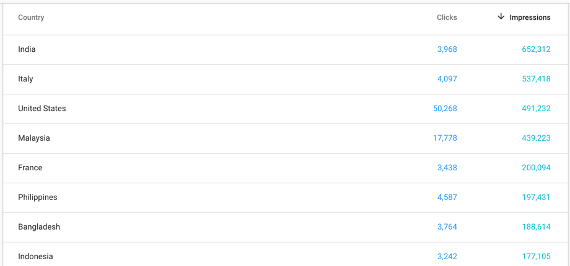
Does your CMS Create Correct XML Site Maps?
August 26, 2021Does HREFLang help with Indexing?
July 21, 2022I am encountering more and more cases of large multinational sites are markets, especially dominant markets, resist hreflang implementation or being fixed as they fear it may cannibalize their traffic numbers. This often happens due to these sites may have been around longer and/or have more authority or relevance.
In this specific article, I do not mean resistance to implementing hreflang due to legitimate concerns especially the overall complexity of implementing hreflang. There might be regional CMS challenges where they are either in a migration to a new CMS or the URL structures so different from each other do not allow for easy page mapping. These are major technical issues that could potentially cannibalize IT resources that the team believes may be more important to them.
Ok, I will say it out loud… the team that controls the master dot com website, often the US team, has a KPI to drive traffic and does not want to lose it nor do they need to care about KPI’s in other markets. As we have said multiple times, the only people who really care about overall global performance are investors and senior global management who ironically are the ones that set market-specific KPI’s that foster this very problem.

The screen capture of Google Search Console below is a great example of a global product page cannibalizing nearly 3.2 million impressions. Nearly 97% of searchers that saw this site in the search results did not click. We can assume it had a SERP headline noting it was the US website. Might we assume the 1.1 million searchers from India and Italy were not interested in the US/Global website? The web analytics identified a 98% bounce rate from those searchers outside the US.
Not having hreflang implemented is costing this business significant revenue opportunities. Swapping out the correct market site to any of these markets and getting at least a 10% click rate would drive nearly 300k visitors into the respective market sites. So what are local markets and regions to do?
Option 1 – Petition Support from Global Executives
Finding a passionate supporter can sometimes be challenging in companies with decentralized market strategies, as there may not be anyone genuinely responsible for the growth across all markets. Within centralized companies, we are finding the perfect person with one of the new fancy “growth” titles like Chief Growth Officer. Especially in eCommerce companies, the Growth Manager is responsible for ringing the cash register across all markets. Since their primary KPI is incremental growth, redirecting missed opportunities makes them one of the best advocates for hreflang adoption.
Option 2 – Demonstrate Negative Impact with Data
You will likely need to demonstrate actual traffic cannibalization and where possible negative revenue impact by the market before any real action is taken. The more accurate and segmented your analytics is the easier it will be to demonstrate the negative impact. You can use any of the following to show the impact.
Shopping Basket Abandonment Rates
Every eCommerce site monitors abandonment rates and will make hundreds of changes to their checkout process to reduce them, but they are often unaware of the biggest problem.
It is not surprising that abandonment rates for sites in Asia Pacific 76.3%, Middle East 76.1%, and Latin America 75.3% are the highest as this is where companies often try to leverage broad regional sites covering all markets and/or we have the most language-site conflicts with Arabic, English, and Spanish. Given that the wrong site is ranking users may not be aware and go to check out and encounter the biggest abandonment reason “High Shipping Costs.”
At a conference, an Australian e-commerce site heard me talk about this concept and sent me a note that they dug into it. They looked at bounce rates that gave one of those reasons and found that over 70% of exits were from markets other than Australia and the shipping to their market was too expensive. They estimated this problem alone cost them over $3 million USD in lost revenue every month. Once they implemented hreflang their abandonment numbers declined exponentially in all markets and sales increased.
Traffic and Sales Impact from Analytics
Using the simple data in the Google Search console above, we identified a missed opportunity of 3.2 million impressions in a single month. By looking at impression, click, and bounce metrics for each market we can see if other issues may impact clicks.
For a large electronics retailer in Latin America, we found that Google was indexing their Argentina site and showing it in other markets in Google Search Results. The sites were on a dot-com platform using nearly exact Spanish content in pages placed in a country folder structure it was hard for Google to know that they were for specific markets and considered them duplicates. In interviews in local markets consumers told the local brand managers in Peru they did not want to buy from a site in Argentina or Mexico. The country name in the SERP heading was preventing consumers from even clicking. By leveraging hreflang in the region, we distinguish these as individual market sites resulting in significant increases in traffic and sales in each of the nearly dozen Spanish language markets.
Option 3 – Proof of Concept
For many organizations having a champion and wowing management with compelling data may not be enough for full adoption resulting in the need to executive a proof of concept to validate your business case, especially with complex websites.
The most obvious implementation is Cannibalized Market Pairs – using the data gathered to demonstrate cannibalization you can deploy hreflang for those market pairs. You can take baby steps and deploy one or two high-value markets to test the performance of hreflang. For example, if a significant number of UK pages are ranking well in Australia, you can deploy hreflang quickly using XML site maps for UK and Australia and then review rank reports to demonstrate the change in positions in search results and most importantly, did traffic and sales from Australia increase once the Australian pages replaced UK pages.
Option 4 – Going Rogue
In some companies, this may be a career-limiting move but where you have a lot to gain the market(s) or region, go it alone by deploying hreflang via XML site maps and hosting them locally or on a neutral domain using cross-domain mapping. This approach can work if it does not conflict with an existing solution. If one set of sites only uses language for hreflang and another listed uses language-region settings, this will cause a problem. This approach requires a method such as HREFLang Builder to develop hreflang XML sitemaps and a location to hold them. This is a deal-breaker to your plans if the global IT team is not willing to host them. You can bypass this barrier by deploying hreflang via XML site maps and hosting them locally or on a neutral domain using cross-domain mapping. You may also want to suggest the centralized management of XML and hreflang XML sitemaps.
Any of these options can help you demonstrate the need to solve a problem that the company may not be aware of. You can work with HREFLang Builder’s consultants to develop a proof of concept that is right for your specific needs.


